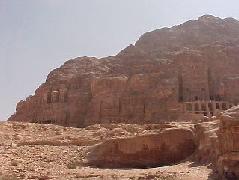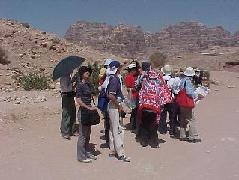Jordan abounds in archaeological riches,from Neolithic ruins to the desert castles of Omayyad princes.
 Chief among these national treasures is the soul-stirrlng,rose-red city of Petra,now a UNESCO World Heritage Site.
Chief among these national treasures is the soul-stirrlng,rose-red city of Petra,now a UNESCO World Heritage Site.Petra is the legacy of the Nabataeans,an industrious Arab People who settled in south Jordan more than 2,000 years ago.From a hidden staging post,they dominated the trade routes of ancient Arabia,1evying tolls and sheltering caravans laden with Indian spices and silks,African ivory and animal hides.
 The Nabataean Kingdom endured for centuries,and Petra became widely admired for its refined culture,massive architecture and ingeniou complex of dams and water channels.Ultimately,however,the Roman Emperor Trajan annexed the Kingdom,and myriad rulers followed in his wake.
The Nabataean Kingdom endured for centuries,and Petra became widely admired for its refined culture,massive architecture and ingeniou complex of dams and water channels.Ultimately,however,the Roman Emperor Trajan annexed the Kingdom,and myriad rulers followed in his wake.By the 16th Century,Petra was completely lost to the West,and so it remained for almost 300 years. Then in 1812,a Swiss traveller named Johann Ludwig Burckhardt persuaded his guide to take him to the site of the rumoured lost city.
Secretly making notes and sketches,he wrote,"it seems very probable that the ruins at Wadi Musa are those of the ancient Petra."
Much of Petra's appeal comes from its spectacular setting deep inside a narrow desert gorge. From the main entrance,you walk into the chasm,or siq,that ripped through the rock in a prehistoric quake.Threading your way between the cliff walls as they soar to 200 meters,you pass inscripptions in ancient languages and rock-cut chambers carved into the whorls of sandstone.
Petra's most famous monument,the Treasury,appears dramatically at the end of the siq.Used in the final sequen of the film Indiana Jones and the Last Grusade,this towering facade is only the first of Petra's secrets.Various walks and climbs reveal literally hundreds of buildings,facades,tombs,baths,funerary halls,temples and haunting rock drawings and reliefs-enough to keep you here for many days.You find a 3,000-seat theatre from the early 1st Century AD,a Palace Tomb in the Roman style,a gigantic 1st-Century Deir(Monaster).A modest shrine commorating the death of Aaron,brother of Moses,was built in the 13th Century by the Mamluke Sultan,high atop Mount Aaron in the Sharah range.
These sights are at their best in early morning and late afternoon,when the sun warms the multicolored stone,and you can view the majesty of Petra as Burckhardt saw it in1812.When he made his journey,the road was long and aduous. Now a few hours'drive from Amman brings you to this uforgettaable destination.
Provided by JORDAN TOURISM BOARD